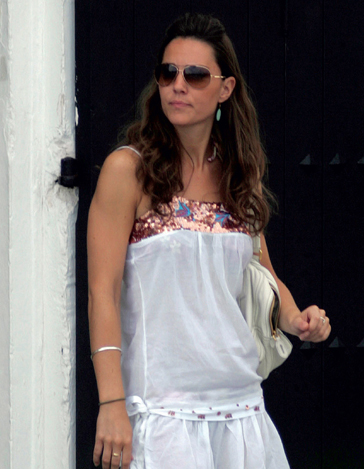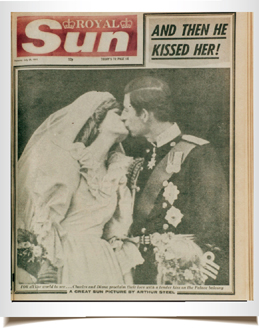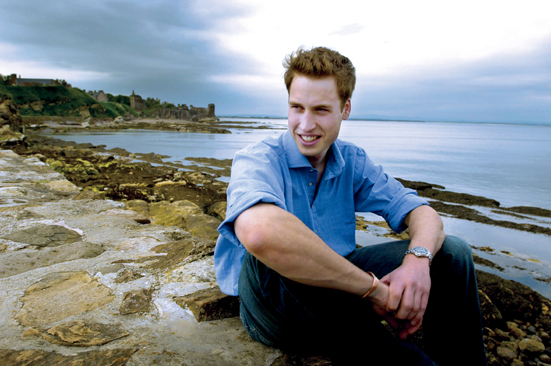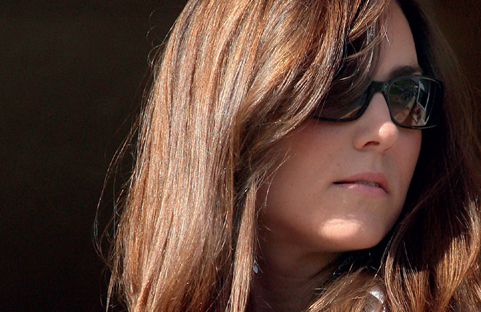
Полная версия
William and Kate: A Royal Love Story


WILLIAM
A Royal Love Story
& KATE

Contents
Cover
Title Page
Introduction
Chapter 1 - Worlds Apart
Chapter 2 - A Schoolgirl Crush
Chapter 3 - Catwalk Queen
Chapter 4 - From Housemates to Dates
Chapter 5 - Rivals, Rows, and the Real World
Chapter 6 - Soldier, Soldier
Chapter 7 - Work Hard, Play Hard
Chapter 8 - Splitting Up ... and Getting Back Together
Chapter 9 - The Waiting Game
Chapter 10 - The Pilot Prince
Chapter 11 - Wait and See
Chapter 12 - The Future King and Queen
Copyright
About the Publisher

Introduction
The outpouring of joy at the news of Prince William’s long-awaited engagement to the beautiful Kate Middleton should come as no surprise to anyone. William has always held a special place in the hearts of the British people, who have recognised qualities in Kate that make her a perfect future Queen.
Patriotic supporters of the Royal Family have closely followed every twist and turn of William’s life as though he were a favourite nephew or the son of a best friend. During his teenage years, there was an enduring fascination over who he would choose to become his wife. The Sun was the first newspaper to tell the world that William had fallen in love with Kate. From that day on, the public paid close attention to the shapely brunette and were charmed by everything they saw. The national obsession over William’s love life subtly shifted from ‘Who?’ to the pressing question of ‘When?’
In finally asking Kate to marry him, William is set to wed a young woman who boasts a winning combination of glamour, grace, poise and intelligence. Many believe that she will now enchant us in the same way as her future husband’s late mother, the immensely popular and beguiling Princess Diana. Those who have closely monitored the couple’s relationship are convinced that they make a better match than Diana and Prince Charles, William’s father. A mere six months separates them in age rather than the 12-year gulf that divided Charles and Diana. They share similar interests, character traits and a healthy desire for normality in spite of their unique circumstances.


Yet in almost every way, their backgrounds could not be more different – as you would expect from a union between a young man born to be King and a girl from the Home Counties.
‘William is set to wed a young woman who boasts a winning combination of glamour, grace, poise and intelligence.’


Chapter 1 - Worlds Apart
With every imaginable privilege available to him and flunkies on hand to attend to his every whim, William should have enjoyed a dream upbringing. But ironically it was Kate who had the more enviable start in life, basking in the warmth of her family’s stability, security and love.
Catherine Elizabeth Middleton was born on 9 January 1982, to mum Carole and dad Michael in Reading’s Royal Berkshire Hospital. Just over eighteen months later she was joined by a sister, Pippa, and, three and a half years after that, a brother James arrived. Carole Goldsmith was working as an air hostess in the 1970s when she met her man. Michael Middleton was a pilot whose powerful masculine looks made him very popular amongst female flight attendants. After a brief time dating, Michael and Carole married in Chiltern, Buckinghamshire, in 1980.
Kate was born two years later and spent the first 13 years of her life growing up in the village of West View, near Bradfield Southend, Berkshire. Her parents had bought the four-bed semi-detached Victorian villa for £35,000 in 1979 – and it was from here that they made a very important life decision. It is one that has almost certainly contributed to Kate’s position today. They were determined to give everything to their children and agreed that international jet-setting was not compatible with family life. They left the airline industry to set up Party Pieces, a mail-order company supplying packs of goodies to guarantee the perfect kids’ bash. Appropriately, wedding kits and princess costumes are amongst the items now shipped by the family firm’s successful online operation.
In 1987, Carole launched the business from a back-garden shed, later expanding into a small industrial unit in nearby Yattendon. Eight years on, the growing firm moved base again into converted farm buildings a mile down the road. In the same year, the family paid £250,000 for a home in the village of Bucklebury. The five-bedroom detached property set within woodland is now worth more than £1 million.
Kate experienced an idyllic childhood, growing up in picture-postcard English villages with parents who packaged and sold fun for a living. A blog she wrote on the Party Pieces website years later provides a telling insight into her carefree youth. She portrayed herself as a happy and outgoing child who loved to dress up as a clown in giant dungarees at fancy dress parties. She described her best party memory as ‘an amazing white rabbit marshmallow cake that Mummy made when I was seven’. Musical statues, she revealed, was a favourite game because she had ‘always been a keen dancer’. Party bags were best, she said, when they contained ‘anything that Mummy would normally never allow me to have. They were always such a treat.’ She recommended cooking parties for girls and camping parties for boys because they were ‘a great way to get Daddies involved’. And she admitted she had suffered a ‘cake disaster’ during James’s birthday when she forgot to add self-raising flour and turned a flat sponge into a trifle cake.




When William and Kate speak about their respective childhoods, her innocent memories must seem a million miles from some of his painful recollections. His youth was blighted by the trauma of his parents’ marriage breakdown and the tragically premature death of his mother – all played out in the media spotlight.
Life began promisingly enough for Prince William Arthur Philip Louis Wales, the boy destined one day to become the 42nd monarch since William the Conqueror took the English throne in 1066. His birth at St Mary’s Hospital in London on 21 June 1982 was met with a 41-gun salute, the sounding of bells and rejoicing that reverberated around Britain and beyond. It came 11 months after Prince Charles, the Queen’s eldest son, had tied the knot with the then Lady Diana Spencer.
Their fairy-tale ceremony at St Paul’s Cathedral was watched by a worldwide audience of 750 million people who were transfixed by the pomp and pageantry.
‘Diana made it her mission to give them a sense of fun, freedom and – most importantly – normality.’
William inherited his mother’s good looks, his father’s inquiring nature and – as the passing years would reveal – the House of Windsor hairline. Prince Harry was born just over two years after William, and the two were to become close friends and allies.
They were brought up in palatial surroundings, with nanny Barbara Barnes keeping a watchful eye over them in their early years.
Being a Prince certainly had many advantages over being a commoner. William once received a £60,000 scaled-down Jaguar car for his birthday, making Kate’s clown dungarees look rather small beer in comparison. On another occasion, he jokingly threatened a school rival with his grandmother’s soldiers during a row.
But as he got older, there was no hiding from the fact that his parents’ marriage was collapsing in front of his – and the nation’s – eyes. Whoever was to blame for the relationship’s failure – and everyone had an opinion – there was universal sympathy for William and Harry when Charles and Diana split in 1992. At an age when Kate was playing musical statues, William was caught in the middle of a brutal separation that infamously contributed to the Queen’s ‘annus horribilis’.
In spite of this, even Charles and Diana’s worst critics would concede that individually they had done their very best for their sons. Diana made it her mission to give them a sense of fun, freedom and – most importantly – normality. Charles was determined that they would not suffer the torment that he had endured at the tough Gordonstoun public school in Moray, Scotland. He also fought to shield William and Harry from the prying eyes of the newspapers and television cameras.
But nothing could prepare them for the shocking death of their mother in a car crash in the Pont de l’Alma road tunnel, Paris, on 31 August 1997. William was just 15 years old – and Harry only 12 – as they walked solemnly in her funeral procession from St James’s Palace to Westminster Abbey. It is a testament to both boys’ strength of character that such a heartbreaking ordeal did not send them spiralling out of control.
Diana would have been proud that her desire for her sons to be grounded shone from them even after she died. It was to prove a quality in William that a girl like Kate would find especially appealing.


Chapter 2 - A Schoolgirl Crush
Carole and Michael Middleton were utterly determined to give Kate, Pippa and James the best possible start in life. The burgeoning success of Party Pieces provided them with the necessary funds to invest in a private education for their children. From the age of 4 to 12, Kate was sent to St Andrew’s prep school in Pangbourne, Berkshire. This £10,000-a-year institution was just a few miles from the family home in Bucklebury, and, as far as her development was concerned, it wasn’t long before the hefty fees seemed to pay off.
She immersed herself in school life. Kate was one of the most popular and successful pupils at St Andrew’s. In the school magazine, The Chronicle, her achievements were splashed across most pages. She was a tennis champion and the captain of the rounders, netball, cross-country and swimming teams. The sports master showered her with praise when he wrote of her hockey skills:
She is a quick and talented player, although at times she can be erratic...
And in athletics, she held both the long and high jump school records. A former St Andrew’s pupil recalls:‘Kate was so sporty. In many ways she was a real tomboy and the teachers loved her.’
Her talents stretched beyond the sports field and into amateur dramatics. In 1993, The Chronicle records her appearance as a Junior Rat in a school production of Ratz. Later that year, she took the lead part of Eliza Doolittle in the classic My Fair Lady. According to The Chronicle of June 1994, Kate ‘glided about the stage looking stylish and serene’. It was not surprising that she was rewarded for all her work, winning that year’s prize for ‘all-round effort and pleasantness’. Her friend added: ‘She was a model pupil. In fact she was from a model family. Her parents were really supportive of all three children. They regularly got involved with the school and a lot of the girls even had a bit of a crush on Kate’s dad Michael. They were really down to earth, a normal happy family, and the stability undoubtedly rubbed off on Kate. She was very mature for her age and things just didn’t seem to bother her in the way that they did everyone else.’
Kate left St Andrew’s at 11 to attend Downe House in Newbury, where she spent two apparently unhappy years. She then transferred to the exclusive £26,000-a-year Marlborough College in Wiltshire, where she boarded in Elmhurst House.
In February 1998, a rumour bounced off the mixed public school’ s corridors the day before a hockey match. The excited chattering was loudest amongst the female students. ‘He’s coming here - he’s actually coming here,’ they shrieked. ‘And better still, he’ll be wearing shorts!’ By the time ‘he’ finally arrived, the banks around Marlborough’s hockey pitches were packed with pupils determined to catch their first glimpse of Prince William.


The young Prince had attended the pre-prep Wetherby School in Notting Hill, West London, followed by Ludgrove School in Wokingham, Berkshire. From there, he passed the entrance exams for the world-renowned Eton College - an achievement that delighted his father, who saw it as infinitely preferable to his old school, Gordonstoun. And it was the hockey team from Eton that was due to take on Marlborough for the annual inter-school fixture.
Former pupils at Marlborough are unlikely to remember the final score. But few of those who watched the game will ever forget the day they saw William up close. Yet not a single person crammed onto the rain-sodden sidelines realised what they were actually witnessing. That muddy match produced one of the most important moments in modern Royal history. Hidden amongst the hordes of admiring young girls was, of course, the 16-year-old Kate Middleton.
It was the first time William’s bride-to-be had clapped eyes on the man she would one day marry.
A fellow schoolmate recalled the air of anticipation surrounding the game. She said: ‘Like all of us Kate was excited. She wasn’t a shy girl at school but at the same time she was far more level-headed than most of her classmates. Several of them were almost hysterical about seeing Prince William in the flesh. Everyone wanted to catch his eye or, better still, get to talk to him. A few of the girls even put on make-up and made a special effort with their hair in the hope of making an impression. But Kate was above all that. As ever, she just played it cool and came with us to watch.’


‘She was a model pupil...Her parents were really supportive of all three children.’
Sadly, the heavens opened and the day didn’t quite play out as many of the Marlborough girls had hoped. The school chum remembered: ‘In the end, we all got soaked and none of us got to speak to William. Looking back, it seems amazing that William and Kate would eventually end up together.’
Seeing the second-in-line to the throne in the flesh apparently confirmed the schoolgirl crush Kate had harboured for some time.
Another former school friend, Jessica Hay, who knew Kate as Catherine, said: ‘Another girl predicted Catherine would fall in love with a prince. She would tell Catherine that one day she would be the Queen of England - and she would shriek in disbelief.’
Jessica said that Kate was jokingly known to pals as ‘princess-in-waiting’ and insisted that William would be her first serious boyfriend. Racy Kate also occasionally joined in with wilder spirits by mooning out of the window as goggle-eyed lads strolled past. Jessica said: ‘One night I told her to just do it and she did. She would have been 14 at the time.’


Kate is now known to the public by her trademark glossy chestnut hair, stylish dress sense and confident manner. But this was not always the case. In fact Kate - known to some at school as ‘Middi’- was the most unlikely of girls to catch a prince’s eye. Plain but popular, she continued to excel at sport and was ‘solid’ academically but did not tick the boxes of a potential princess-in-waiting.
Other more suitable candidates were growing up in stately homes, polishing their nails along with their manners. But while they were learning how to behave within the upper classes, Kate was different.
It was only in her last year at Marlborough that Kate finally began blossoming into a confident young woman. She also hit her academic stride, following her high-grade passes in 11 GCSEs with three good A-levels. The friend said: ‘She went to a party just a few weeks before her A-levels and she was the one girl all the guys wanted to chat up. She was tanned, had an athletic body and lovely legs - basically they all lusted after her. Even the way she talked had changed. Her accent had become more posh and it was as though she was trying to shake off those middle-class roots.’

William, meanwhile, gained A-levels in geography, history of art and biology, respectively scoring A, B and C grades. Then - just like Kate and thousands of other well-heeled students - he embarked on a gap year. He would enjoy many memorable experiences, including a safari in Africa, volunteer work in Chile and grafting as a farm labourer in England.
He had no doubt long since forgotten about the hockey match against Marlborough. But while he may not have spotted Kate that day, he would get to see a whole lot more of her at his next educational waypoint.
‘Her accent had become more posh and it was as though she was trying to shake off those middle-class roots.’
GIRL ON THE BUS
Kate endeared herself to the public after she was spotted travelling on a bus. She took the number 19 from Chelsea into the West End on a shopping trip in October 2005. Six months later she was snapped waiting for the number 137 in Sloane Square after enjoying a lunch with her mum.
One onlooker said: ‘At the bus stop she completely blended in and certainly did not stand out from the crowd.’ She wore sunglasses for the second outing and wasn’t disturbed by other passengers.
Her lawyers Harbottle & Lewis were unhappy about the pictures and complained that her privacy was being invaded. But the British people were charmed – a possible future Queen free from airs and graces, and using public transport.
Maybe she should have stuck to buses for a little while longer. In October 2008, she was snapped talking on her mobile phone while driving – but wasn’t prosecuted.


Chapter 3 - Catwalk Queen
The air of excitement around the University of St Andrews was palpable as the new intake of first years arrived in autumn 2001. For the young men already attending the esteemed establishment in Fife on the east coast of Scotland, it meant plentiful supplies of pretty fresher girls ripe for chatting up. But for the female students it signified something else altogether: Prince William, the world’s most eligible bachelor, was about to hit town.
It was a matter of weeks since New York’s Twin Towers had collapsed in a shocking terrorist attack, but William’s imminent appearance still dominated many conversations. His decision to enrol on a history of art degree had sparked unprecedented interest in Scotland’s oldest uni. An incredible surge in applications - a 44 per cent increase on the usual number - thunked with deafening inevitability onto the admissions office mat. Many were from husband-hunting US society girls, each of them dreaming of landing a British Royal. All 130 places on the four-year course were snapped up within hours of the news that the young Prince had, somewhat unsurprisingly, been granted his place.
Kate Middleton - fit, fresh and ready to study after her gap year in Italy and South America - was amongst their number.

William skipped Freshers’ Week, the traditionally boozy opening days of university life, in a bid to avoid handing the press a field day. ‘It would have been a media frenzy and that’s not fair on the other new students,’ he said. ‘Plus I thought I would probably end up in a gutter, completely wrecked, and the people I had met that week wouldn’t end up being my friends anyway.’ He added with some candour: ‘It also meant I could have another week’s holiday.’
The casually dressed Prince was finally dropped off at St Andrews after being driven there by Prince Charles in a green Vauxhall Omega estate. He was greeted by the principal Dr Brian Lang, 4,000 well-wishers and a group of protesters venting their feelings over the looming war in Afghanistan. William shook the hands of those there to welcome him and seemed refreshingly convinced that the level of interest in him would rapidly subside. ‘It will be easier as time goes on,’ he said. ‘Everyone will get bored of me, which they do.’
Home for the next academic year would be a £2,273-a-year en-suite room in St Salvator’s hall of residence - affectionately known as St Sally’s - with protection officers in rooms on either side of him. As fate would have it, Kate had only just finished unpacking her bags inside her new digs on a different floor of the same mixed college.
As earnestly as William hoped that his peers would ‘get bored’ of him, it was a mere matter of days before controversy erupted.
Students complained of an uninvited and unwanted film crew lurking in the shadows of the old town’s streets. Palace aides had brokered a deal with the media that they believed would guarantee William privacy while he was in higher education. To hear that it was being flouted so flagrantly and so early in his studies enraged them.



Then, to the complete disbelief of all concerned - but especially to William and his dad - it emerged that the camera team had a Royal link. They had been sent by Ardent Productions, the TV company run by Prince Edward, Charles’s youngest brother and William’s uncle. Understandably, the young Prince was livid at the betrayal and rang his dad to complain. Charles made his feelings known to Edward in no uncertain terms.


